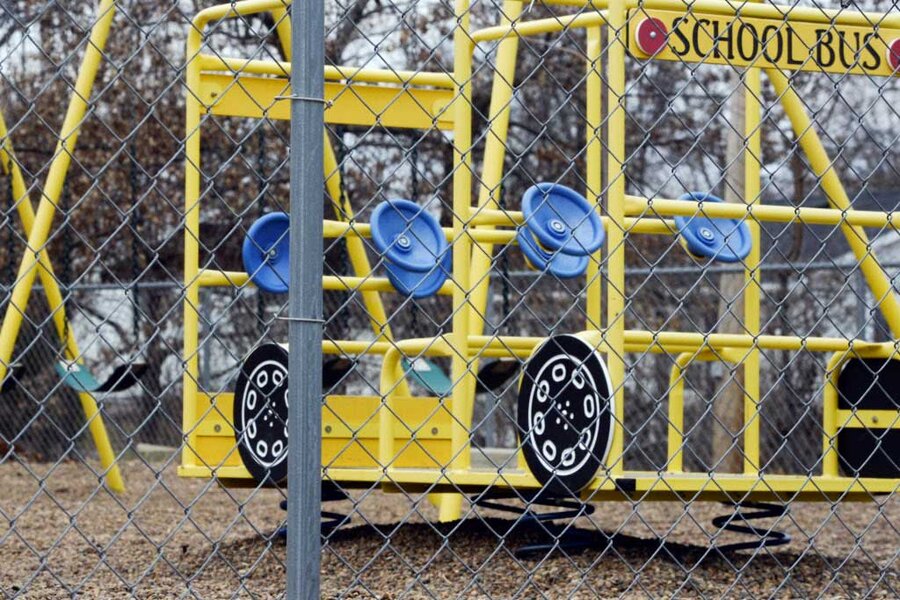Church, state, and school: What might Supreme Court ruling mean for vouchers?
Loading...
Dig beneath the rubber playground surface at issue in the latest landmark case before the United States Supreme Court and you’ll find a tricky question – a conundrum born out of the gray area between the Constitution’s two key religious protection provisions.
Dig a little deeper, and you’ll find potentially momentous implications for the nationwide debate over school choice voucher programs.
The case to be argued before the high court on Wednesday – now with a full complement of nine justices after Justice Neil Gorsuch took his seat at the bench this week – dates back to 2012, when the Trinity Lutheran Church in Columbia, Mo., applied for a state grant to fund the resurfacing of its preschool’s playground with recycled tire rubber. While the state ranked the church’s application fifth out of the 44 it received, it denied the application, citing a provision in the Missouri constitution – known colloquially as a Blaine amendment – that prohibits money from the state treasury from going “directly or indirectly in aid of any church, sect, or denomination of religion.”
Trinity Lutheran challenged the decision in federal court, saying it violated both the free exercise and equal protection provisions of the First Amendment, but both the district court and the 8th Circuit court of Appeals ruled for Missouri. The Supreme Court agreed to hear the case 15 months ago, and the unusually long wait before arguments (the longest such delay in 2015 was 12 months) is one sign of how contentious the case could be, with the justices possibly delaying until a ninth justice took office to avoid a 4-to-4 tie. (Missouri Gov. Eric Greitens announced a change in the state policy last week, saying religious organizations are now eligible for those grants, but the case itself is still scheduled to proceed.)
The Trinity case could just be the beginning of “a pivotal period” for the school voucher movement in America, says Patrick Wolf, a professor of education policy at the University of Arkansas.
“It’s either going to reach escape velocity and just become a much more prominent part of our education system,” he says, “or it’s going to be heavily constrained in this moment.”
The core question is complex, asking at what point separating church and state becomes so involved that it harms churches. But what does it have to do with vouchers programs?
The answer lies in the Blaine amendments. Modeled on – and named after – a failed amendment to the federal constitution proposed by 19th-century Republican Congressman James Blaine, they are provisions in state constitutions that prohibit direct government aid to parochial schools (provisions that historians believe were motivated by a fear of Catholic teachings infiltrating schools).
Missouri is one of 38 states with such an amendment, and since about two-thirds of schools participating in voucher programs across the country are religious – according to research from Professor Wolf – Blaine amendments have for decades been an obstacle to implementing voucher programs around the country.
If the Supreme Court were to issue a decision supporting Missouri’s Blaine amendment, it “would restrict” the options parents have to enroll their children in private schools, strengthening prohibitions against funding for religious schools, says Wolf, who supports school choice.
On the flip side, if the court rules broadly the other way then it could invalidate Blaine amendments nationwide, and voucher programs could grow exponentially.
“To rule against the Blaine Amendments would open the door to subsidizing religious schools with public dollars,” wrote Diane Ravitch, a public schools advocate and former assistant Education secretary in the George H.W. Bush administration, in The Washington Post.
As with many Supreme Court cases however, broad decisions are the least likely kinds of decisions.
Firstly, the justices may choose to re-tread safer ground already covered by the court. In 1947’s Everson v. Board of Education, the high court ruled that it would not be unconstitutional for a state to provide to parochial schools services like busing and emergency services protection that are “indisputably marked off from the religious function” of the school. The justices could decide that Missouri’s recycled tire program falls into the category of bus and fire services, which wouldn’t touch the federal constitutionality of school voucher programs writ large.
The court may also have a better case waiting in the wings.
The justices have agreed to hear arguments in a case out of Colorado, where the state supreme court struck down a school voucher program there because it would violate the state's Blaine amendment. Lower courts around the country have offered starkly different interpretations of various Blaine amendments – supreme courts in Wisconsin and Arizona ruled the opposite way from Colorado, for example – which is a classic precursor to Supreme Court intervention.
“If the church wins in Trinity Lutheran, Douglas County [the Colorado case] will probably be vacated and remanded to the Supreme Court of Colorado,” writes Douglas Laycock, a professor at the University of Virginia Law School, in an email to the Monitor.
“Whatever that court decides would tee up the schools issue for the Supreme Court,” he adds. “A win on the merits for Douglas County would probably make [Blaine amendments] mostly irrelevant.”
Either way, the Supreme Court is likely to make a big decision on voucher programs soon, and that decision could also be pivotal for American churches generally.
In Milwaukee, home to the country’s first ever school choice program (created in 1990), Catholic churches now get more revenue from vouchers than any other source, according to research from Daniel Hungerman, an associate professor of economics at the University of Notre Dame in Indiana.
“The legal landscape [around school choice] going forward is going to matter a lot for the bottom line of churches,” he says. “When you think about school choice, and when you think about American religion, in the coming decades the future of those two things may be very much intertwined.”






